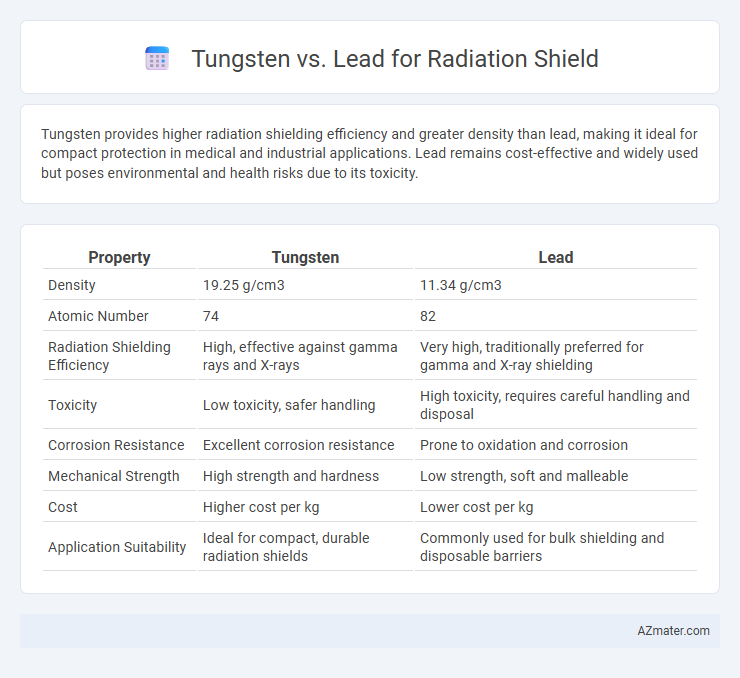Tungsten provides higher radiation shielding efficiency and greater density than lead, making it ideal for compact protection in medical and industrial applications. Lead remains cost-effective and widely used but poses environmental and health risks due to its toxicity.
Table of Comparison
| Property | Tungsten | Lead |
|---|---|---|
| Density | 19.25 g/cm3 | 11.34 g/cm3 |
| Atomic Number | 74 | 82 |
| Radiation Shielding Efficiency | High, effective against gamma rays and X-rays | Very high, traditionally preferred for gamma and X-ray shielding |
| Toxicity | Low toxicity, safer handling | High toxicity, requires careful handling and disposal |
| Corrosion Resistance | Excellent corrosion resistance | Prone to oxidation and corrosion |
| Mechanical Strength | High strength and hardness | Low strength, soft and malleable |
| Cost | Higher cost per kg | Lower cost per kg |
| Application Suitability | Ideal for compact, durable radiation shields | Commonly used for bulk shielding and disposable barriers |
Introduction to Radiation Shielding Materials
Tungsten and lead are widely used materials for radiation shielding due to their high atomic numbers, which enable effective attenuation of ionizing radiation such as X-rays and gamma rays. Tungsten offers superior density (19.3 g/cm3) and higher melting point (3422degC) compared to lead (11.34 g/cm3, melting point 327.5degC), resulting in thinner, more durable shielding solutions with enhanced mechanical strength. Lead remains popular for its cost-effectiveness and ease of fabrication despite lower density and toxicity concerns that limit its applications in modern radiation protection.
Overview of Tungsten and Lead
Tungsten and lead are commonly used materials for radiation shielding due to their high density and atomic numbers, which enable effective attenuation of ionizing radiation. Tungsten has a density of approximately 19.3 g/cm3 and an atomic number of 74, offering superior shielding capabilities and mechanical strength, while lead, with a density of about 11.34 g/cm3 and atomic number 82, provides cost-effective and easily malleable protection. Tungsten's higher melting point and structural robustness make it suitable for high-temperature and high-stress environments, whereas lead remains popular for medical and industrial radiation shields due to its affordability and ease of fabrication.
Density and Atomic Number Comparison
Tungsten has a density of approximately 19.3 g/cm3 and an atomic number of 74, while lead's density is about 11.34 g/cm3 with an atomic number of 82. The higher density of tungsten provides superior radiation shielding by absorbing more energy per unit volume, despite lead's slightly higher atomic number, which contributes to better attenuation of X-rays and gamma rays. Selecting tungsten or lead for radiation shielding depends on balancing material density and atomic number to optimize protection effectiveness and weight considerations.
Radiation Attenuation Capabilities
Tungsten exhibits superior radiation attenuation capabilities compared to lead due to its higher atomic number (74 versus 82) and greater density (~19.3 g/cm3 for tungsten vs. 11.34 g/cm3 for lead), resulting in more effective absorption of gamma rays and X-rays. Its high density and electron density enhance interaction probabilities with incoming radiation, providing improved shielding efficiency in thinner, lighter designs. Tungsten's enhanced attenuation performance makes it a preferred material for advanced radiation shielding applications in medical, industrial, and nuclear environments.
Weight and Space Considerations
Tungsten offers superior radiation shielding with higher density (19.25 g/cm3) compared to lead (11.34 g/cm3), enabling thinner and lighter shields in space-constrained applications. Although tungsten is heavier by volume, its compactness reduces overall shield size, ideal for aerospace or medical devices where minimizing space is critical. Lead's lower cost and ease of fabrication often make it practical despite bulkier and heavier shields.
Durability and Longevity
Tungsten offers superior durability and longevity compared to lead when used as radiation shielding due to its higher density and melting point, enabling it to withstand extreme conditions without degradation. Lead, while effective at radiation attenuation, is softer and prone to deformation and corrosion over time, which can compromise its shielding integrity. The enhanced resilience of tungsten makes it the preferred choice in applications requiring long-term, reliable radiation protection.
Environmental and Health Concerns
Tungsten offers significant environmental and health advantages over lead in radiation shielding due to its non-toxic nature and lower environmental impact during disposal. Lead exposure is linked to severe health risks, including neurotoxicity and contamination of soil and water, making tungsten a safer alternative for long-term use. The high density of tungsten ensures effective radiation protection while minimizing hazardous waste and occupational health hazards associated with lead.
Cost and Availability
Tungsten offers superior radiation shielding due to its high density but comes with a significantly higher cost and limited availability compared to lead. Lead remains the more economical and widely accessible option, making it the preferred choice for many radiation protection applications despite its lower shielding efficiency. The price difference and supply constraints of tungsten impact its use primarily to specialized or high-performance scenarios.
Application Suitability: Medical, Industrial, and Nuclear
Tungsten offers superior radiation shielding in medical applications due to its high density and biocompatibility, making it ideal for X-ray and gamma-ray protection in imaging and therapy devices. In industrial settings, tungsten's durability and resistance to corrosion provide long-lasting performance in radiography and non-destructive testing environments compared to lead. For nuclear applications, tungsten's higher melting point and lower toxicity give it an advantage over lead in managing high-energy radiation and reducing environmental hazards during handling and disposal.
Conclusion: Choosing the Best Material for Radiation Shielding
Tungsten offers superior radiation shielding performance due to its higher density and atomic number compared to lead, providing better attenuation of gamma rays and X-rays with thinner, lighter barriers. While lead is cost-effective and widely used, tungsten's non-toxic nature and environmental safety make it a preferred choice for medical and industrial applications requiring durability and health compliance. Selecting between tungsten and lead depends on specific shielding requirements, balancing factors like weight, thickness, toxicity, and budget constraints for optimal radiation protection.

Infographic: Tungsten vs Lead for Radiation Shield
 azmater.com
azmater.com